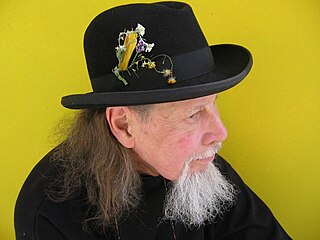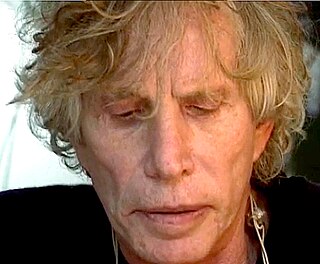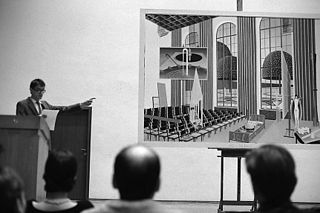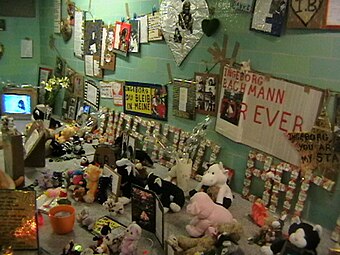Michael Max Asher was a conceptual artist, described by The New York Times as "among the patron saints of the Conceptual Art phylum known as Institutional Critique, an often esoteric dissection of the assumptions that govern how we perceive art." Rather than designing new art objects, Asher typically altered the existing environment, by repositioning or removing artworks, walls, facades, etc.

Performance art is an artwork or art exhibition created through actions executed by the artist or other participants. It may be witnessed live or through documentation, spontaneously developed or written, and is traditionally presented to a public in a fine art context in an interdisciplinary mode. Also known as artistic action, it has been developed through the years as a genre of its own in which art is presented live. It had an important and fundamental role in 20th century avant-garde art.

Antoine Bourdelle, born Émile Antoine Bordelles, was an influential and prolific French sculptor and teacher. He was a student of Auguste Rodin, a teacher of Giacometti and Henri Matisse, and an important figure in the Art Deco movement and the transition from the Beaux-Arts style to modern sculpture.

Land art, variously known as Earth art, environmental art, and Earthworks, is an art movement that emerged in the 1960s and 1970s, largely associated with Great Britain and the United States but that also includes examples from many countries. As a trend, "land art" expanded boundaries of art by the materials used and the siting of the works. The materials used were often the materials of the Earth, including the soil, rocks, vegetation, and water found on-site, and the sites of the works were often distant from population centers. Though sometimes fairly inaccessible, photo documentation was commonly brought back to the urban art gallery.

Joseph Heinrich Beuys was a German artist, teacher, performance artist, and art theorist whose work reflected concepts of humanism, sociology, and, with Heinrich Böll, Johannes Stüttgen, Caroline Tisdall, Robert McDowell, and Enrico Wolleb, created the Free International University for Creativity & Interdisciplinary Research (FIU). He previously in his talks and performances also formed The Party for Animals and The Organisation for Direct Democracy. He was a member of a Dadaist art movement Fluxus and singularly inspirational in developing of Performance Art, called Kunst Aktionen, alongside Wiener Aktionismus that Allan Kaprow and Carolee Schneemann termed Art Happenings. Today, internationally, the largest performance art group is BBeyond in Belfast, led by Alastair MacLennan who knew Beuys and like many adapts Beuys's ethos.

Meret Elisabeth Oppenheim was a German-born Swiss Surrealist artist and photographer.

The history of sculpture in the United States begins in the 1600s "with the modest efforts of craftsmen who adorned gravestones, Bible boxes, and various utilitarian objects with simple low-relief decorations." American sculpture in its many forms, genres and guises has continuously contributed to the cultural landscape of world art into the 21st century.

Willoughby Sharp was an American artist, independent curator, independent publisher, gallerist, teacher, author, and telecom activist. Avalanche published interviews they conducted with contemporary artists such as Vito Acconci, Dennis Oppenheim and Yvonne Rainer. Sharp also was contributing editor to four other publications: Impulse (1979–1981); Video magazine (1980–1982); Art Com (1984–1985), and the East Village Eye (1984–1986). He published three monographs on contemporary artists, contributed to many exhibition catalogues, and wrote on art for Artforum, Art in America, Arts magazine, Laica Journal, Quadrum and Rhobo. He was editor of the Public Arts International/Free Speech documentary booklet in 1979. Sharp received numerous grants, awards, and fellowships; both as an individual or under the sponsorship of non-profit arts organizations.

Skulptur Projekte Münster is an exhibition of sculptures in public places in the city of Münster (Germany). Held every ten years since 1977, the exhibition shows works of invited international artists for free in different locations all over town, thereby confronting art with public places. After every exhibition, the city buys a few of the exhibited sculptures which are then installed permanently.

Dennis Oppenheim was an American conceptual artist, performance artist, earth artist, sculptor and photographer. Dennis Oppenheim's early artistic practice is an epistemological questioning about the nature of art, the making of art and the definition of art: a meta-art that arose when strategies of the Minimalists were expanded to focus on site and context. As well as an aesthetic agenda, the work progressed from perceptions of the physical properties of the gallery to the social and political context, largely taking the form of permanent public sculpture in the last two decades of a highly prolific career, whose diversity could exasperate his critics.
Steven Holmes is a Canadian curator based in Hartford, Connecticut.

Monument to Balzac is a sculpture by Auguste Rodin in memory of the French novelist Honoré de Balzac. According to Rodin, the sculpture aims to portray the writer's persona rather than a physical likeness. The work was commissioned in 1891 by the Société des Gens de Lettres and a full-size plaster model was displayed in 1898 at a Salon in Champ de Mars. After coming under criticism the model was rejected by the société and Rodin moved it to his home in Meudon. On 2 July 1939 the model was cast in bronze for the first time and placed on the Boulevard du Montparnasse at the intersection with Boulevard Raspail.
Social sculpture is a phrase used to describe an expanded concept of art that was invented by the artist and founding member of the German Green Party, Joseph Beuys. Beuys created the term "social sculpture" to embody his understanding of art's potential to transform society. As a work of art, a social sculpture includes human activity that strives to structure and shape society or the environment. The central idea of a social sculptor is an artist who creates structures in society using language, thoughts, actions, and objects.

The Kunstmuseum Bonn or Bonn Museum of Modern Art is an art museum in Bonn, Germany, founded in 1947. The Kunstmuseum exhibits both temporary exhibitions and its collection. Its collection is focused on Rhenish Expressionism and post-war German art. It is part of Bonn's "Museum Mile".

Object , lit. Object, known in English as Fur Breakfast or Breakfast in Fur, is a 1936 sculpture by the surrealist Méret Oppenheim, consisting of a fur-covered teacup, saucer and spoon.

Marc Bauer is an artist best known for his works in the graphic medium, primarily drawing.

Thomas Huber is a Swiss artist who lived and worked in Mettmann near Düsseldorf for several years and is currently resident in Berlin.
Kent Fine Art is an art gallery in New York City founded in 1985 by Douglas Walla.
Philippe Vergne is a French curator who has been serving as director of the Serralves Contemporary Art Museum since 2019.
Jean-Luc Moulène is a French contemporary artist based in Paris, France. Spanning a wide variety of media, such as photography, drawings, and sculptures, Moulène's practice examines the relationship between systems and orders. Moulène has stated that he subscribes to the notion of a 'disjunction,' whereby he follows a principle of discrepancies as a way to "find new dialectical knowledge." His interests include the "symbolic position of the author" and authorship; processes of production, repetition, and accumulation; labor and social space; and the intersection of advanced technology and contemporary material culture, among others. Moulène identifies himself as a "technicien libertaire", who transforms "the process of perception as an aesthetic end in itself to one that incorporates everyday life" in his work.



















